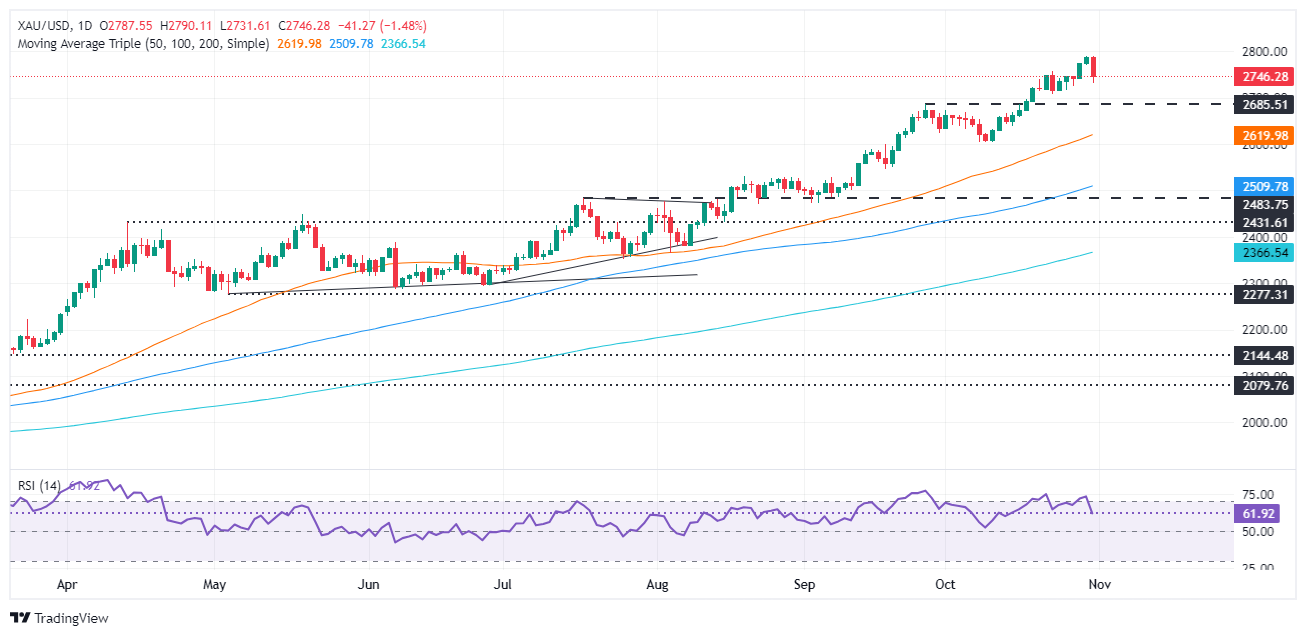- Gold falls from all-time highs amid strong US jobs data and stable core inflation.
- Investors remain risk-averse ahead of the US election on November 5, with polls showing a tight race between Trump and Harris.
- Non-farm payrolls and the Fed’s upcoming rate decision keep traders cautious.
The price of Gold retreated from all-time highs on Thursday as traders failed to capitalize on falling US Treasury yields. However, the precious metal is set to close the month with gains of more than 4% and stay above the $2,700 threshold.
XAU/USD is trading at $2.745, down 1.49%. The yield on the 10-year US Treasury bond fell almost two basis points to 4.284%.
Risk aversion is the tone ahead of the US presidential election on November 5. Meanwhile, the release of the Federal Reserve’s preferred inflation gauge, the Core Personal Consumption Expenditure (PCE) Price Index, along with a strong employment report, weighed on the price of the precious metal.
Meanwhile, the latest opinion polls show that the race for the White House is narrowing between the Republican candidate, former US President Donald Trump, and the Democratic candidate, Vice President Kamala Harris.
US data from the Bureau of Economic Analysis (BEA) showed that headline inflation declined. However, the core Personal Consumption Expenditure (PCE) Price Index, the Fed’s preferred inflation indicator, was unchanged in October compared to the September level.
The US Department of Labor revealed that the number of Americans who filed for unemployment benefits in the week ending October 26 fell to its lowest level in five months.
Geopolitical tensions remain high in the Middle East, despite US Secretary of State Anthony Blinken declaring “good progress” towards a ceasefire in Lebanon. Meanwhile, the Israeli military revealed the movement of ballistic missiles into Iran, hinting that a truce is far from being reached.
Bullion traders are awaiting the Nonfarm Payrolls report and have priced in a 95% chance that the Fed will cut interest rates by 25 basis points next week.
Daily Market Summary: Gold Price Declines Amid Good US Data
- The US Dollar Index (DXY), which tracks the value of the dollar against a basket of six currencies, fell 0.18% to 104.08.
- US headline PCE decreased from 2.3% to 2.1% year-on-year (YoY), moving closer to the Fed’s 2% target. However, core PCE, which excludes volatile items, remained unchanged at 2.7% year-on-year, slightly above forecasts of 2.6%.
- Initial US jobless claims for the week ending October 26 fell from 228,000 to 216,000, below the forecast of 230,000.
- Data from the Chicago Board of Trade, based on the December federal funds rate futures contract, indicates that investors are estimating a 49 basis point (bp) easing from the Fed by the end of the year.
XAU/USD Technical Outlook: Gold Price Retraces Below $2,750 as Bulls Take a Pause
Gold fell from all-time highs, but continues to have a bullish bias. If XAU/USD bulls hold the spot price above $2,700, look for further gains once it breaks the psychological figure of $2,750, ahead of the all-time high at $2,790. A breakout of the latter, and the $2,800 threshold is within reach.
On the other hand, if sellers intervene and push prices below $2,708, where the daily low of October 23 is, it will expose the $2,700 mark. Next is the September 26 high, which became support at $2,685, followed by the 50-day SMA at $2,603.
The momentum suggests that the non-performing metal could consolidate as the Relative Strength Index (RSI) remains bullish. This means that buyers are gaining momentum.
Gold FAQs
Gold has played a fundamental role in human history, as it has been widely used as a store of value and medium of exchange. Today, apart from its brilliance and use for jewelry, the precious metal is considered a safe-haven asset, meaning it is considered a good investment in turbulent times. Gold is also considered a hedge against inflation and currency depreciation, since it does not depend on any specific issuer or government.
Central banks are the largest holders of Gold. In their aim to support their currencies in turbulent times, central banks tend to diversify their reserves and purchase Gold to improve the perception of strength of the economy and currency. High Gold reserves can be a source of confidence for the solvency of a country. Central banks added 1,136 tons of gold worth about $70 billion to their reserves in 2022, according to data from the World Gold Council. This is the largest annual purchase since records exist. Central banks in emerging economies such as China, India and Türkiye are rapidly increasing their gold reserves.
Gold has an inverse correlation with the US Dollar and US Treasuries, which are the main reserve and safe haven assets. When the Dollar depreciates, the price of Gold tends to rise, allowing investors and central banks to diversify their assets in turbulent times. Gold is also inversely correlated with risk assets. A rally in the stock market tends to weaken the price of Gold, while sell-offs in riskier markets tend to favor the precious metal.
The price of Gold can move due to a wide range of factors. Geopolitical instability or fear of a deep recession can cause the price of Gold to rise rapidly due to its status as a safe haven asset. As a non-yielding asset, the price of Gold tends to rise when interest rates fall, while rising money prices tend to weigh down the yellow metal. Still, most of the moves depend on how the US Dollar (USD) performs, as the asset is traded in dollars (XAU/USD). A strong Dollar tends to keep the price of Gold in check, while a weaker Dollar is likely to push up Gold prices.
Source: Fx Street
I am Joshua Winder, a senior-level journalist and editor at World Stock Market. I specialize in covering news related to the stock market and economic trends. With more than 8 years of experience in this field, I have become an expert in financial reporting.








